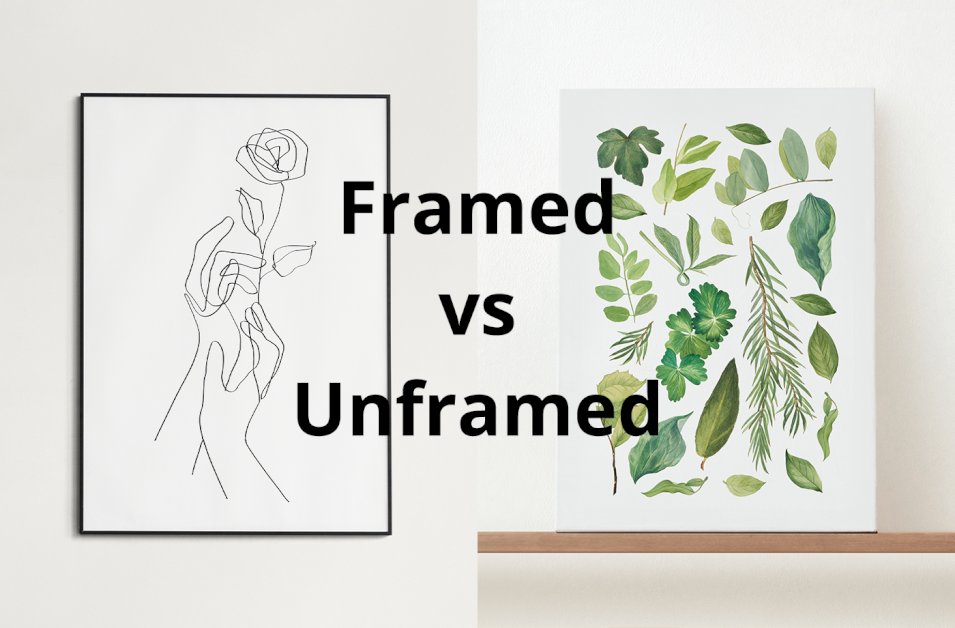Skip the stress of “framing regret.” Explore our straightforward breakdown of the pros, cons, and key considerations. By the end, you’ll know whether your next artwork deserves a frame—or looks perfect just as it is.
What is a framed canvas?

Framed canvas art features a stretched canvas mounted in a decorative frame. The frame, which can be thin or thick, is typically made of wood, metal, or composite materials, serving both protective and decorative purposes.
Pros of framed canvas art
- Presents a polished look: Frames give artwork a refined, gallery-like appearance. They create a distinct border that draws the viewer’s eye to the piece and enhances its presence on the wall.
- Enhanced protection: Frames act as a physical barrier, shielding the edges of the canvas from dust, accidental bumps, and potential damage.
- Style variety: You can select a frame that matches your home décor.
- Ready to hang: Framed canvases typically come fully assembled with hanging hardware, so there’s no need to buy a separate frame or deal with complicated installation.
Cons of framed canvas art
- Added weight: Frames, particularly large ones, make artwork heavier and bulkier.
- Higher cost: High-quality frames can significantly increase the price of the artwork itself, as well as shipping costs.
- Style limitations: Frames offer less flexibility than frameless options if your décor undergoes a major change.
What is a unframed canvas?

A frameless canvas, also called a “gallery-wrapped” canvas, is a printed or painted artwork tightly stretched over a sturdy wooden frame—without an external frame. The canvas wraps around the sides of the wooden frame, often with the image extending to the edges. This modern, minimalist style keeps the focus entirely on the artwork itself, letting colors and textures take center stage.
Pros of unframed canvas art
- Lightweight: Without heavy frames, frameless canvases are easier to hang and transport—especially large pieces—since they don’t require sturdy wall anchors.
- Modern, minimalist aesthetic: They provide a clean, sleek, and contemporary look, eliminating visual clutter.
- Affordable: Skipping the frame can lead to significant cost savings.
Cons of unframed canvas art
- Vulnerable edges: The exposed corners are more prone to bumps and scratches compared to framed edges.
- Lack of traditional feel: For formal or traditional settings, an unframed canvas might seem too casual or unfinished to some.
Key differences: Framed vs. Unframed canvas art
Here’s what really sets them apart:
| Feature | Framed canvas | Unframed canvas |
| Structure |
Canvas + external decorative frame |
Canvas stretched over deep bars, no external frame |
| Edges |
Protected by frame |
Image wraps around sides; exposed canvas edges |
| Aesthetic | Traditional, formal | Modern, minimalist |
| Cost | Higher | Generally lower |
| Weight | Heavier | Lighter |
| Protection | Higher | Lower (edges vulnerable) |
| Flexibility |
You can change the frame style later to fit the decor |
It blends seamlessly into any decor style |
How to choose: Framed or unframed?
You’ve fallen in love with a canvas artwork—but now comes the big question: framed or unframed? There’s no one-size-fits-all answer, but these factors will help you decide with confidence:
Your decorating style:
- Choose framed: Ideal for traditional, classic, or formal spaces. Perfect if you love ornate details or want to create an elegant focal point.
- Choose unframed: Great for modern, minimalist, industrial, or coastal decor. Best for a sleek, seamless look.
The artwork itself
- Choose framed: Protects cherished originals, heirlooms, or delicate pieces. Also suits traditionally framed art (e.g., classical portraits).
- Choose unframed: Works well for modern abstracts, bold photography, large statement pieces, or images that naturally extend to the edges (e.g., sprawling landscapes).
Budget
- Choose framed if you can invest in extra protection and a customizable, polished finish.
- Choose unframed: A budget-friendly option that skips the cost of frames and glass.
Location and environment
- Choose framed: Best for high-traffic areas (like hallways or living rooms), homes with kids/pets, or spaces needing dust resistance.
- Choose unframed: Ideal for low-traffic areas (e.g., bedrooms) or serene settings.
Personal preference
- Choose framed: If you love a timeless, refined look.
- Choose unframed: If you prefer a contemporary, floating-art aesthetic.
Size considerations
- Small works: Frames add weight and make them stand out.
- Large works: Unframed often feels bold and effortless.
Conclusion
Framed or unframed? As we’ve seen, both options create beautiful displays—just in different ways. Framed canvases bring timeless elegance and a formal touch, much like a classic painting. Unframed canvases, however, give a modern, immersive look, letting the artwork stand out on its own.
Don’t stress about finding the “perfect” choice. What matters most is what speaks to you and suits the piece. Think about the artwork’s style, the room’s vibe, and how you want it to fit into the space.
Related article: Metal Prints vs. Canvas
FAQ
Can I frame an unframed canvas later?
Yes. Many gallery-wrapped canvases can be framed later with either a floating frame or a traditional frame.
Which is more durable, a framed or unframed canvas?
Framed canvases typically offer better protection against dust and edge damage. However, both can last for years with proper care.
Are there eco-friendly canvas framing options?
Absolutely! You can opt for frames made from recycled wood or bamboo, as well as eco-friendly inks and painting supplies.
Do unframed canvases look cheap?
Not at all—gallery-wrapped canvases often have a sleek, modern appearance.
Which is better for gifting?
Framed canvases usually make more impressive gifts due to their polished, finished look.




